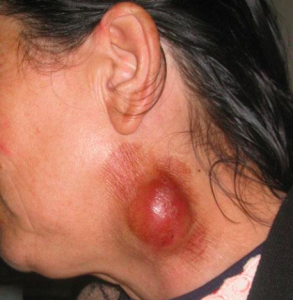Visit and Join the WeHeal Tularemia Community.
For more information, see:MayoCLinic | Wikipedia

Tularemia doesn’t occur naturally in humans and isn’t known to pass from person to person. However, tularemia occurs worldwide, especially in rural areas, because many mammals, birds, insects and fish are infected with F. tularensis. The organism can live for weeks in soil, water and dead animals.
Unlike some infectious diseases that spread from animals to people through a single route, tularemia has several modes of transmission. How you get the disease usually determines the type and severity of symptoms. In general, you can get tularemia through:
Insect bites. Although a number of insects carry tularemia, ticks and deer flies are most likely to transmit the disease to humans. Tick bites cause a large number of cases of ulceroglandular tularemia.
Exposure to sick or dead animals. Ulceroglandular tularemia can also result from handling or being bitten by an infected animal, most often a rabbit or hare. Bacteria enter the skin through small cuts and abrasions or a bite, and an ulcer forms at the wound site. The ocular form of tularemia can occur when you rub your eyes after touching an infected animal.
Airborne bacteria. Bacteria in the soil can become airborne during gardening, construction or other activities that disturb the earth. Inhaling the bacteria can lead to pneumonic tularemia. Laboratory workers who work with tularemia also are at risk of airborne infection.
Contaminated food or water. Although uncommon, it’s possible to get tularemia from eating undercooked meat of an infected animal or drinking contaminated water. The signs include vomiting, diarrhea and other digestive problems (oropharyngeal tularemia). Heat kills F. tularensis, so cook meat to the right temperature — a minimum of 160 F (71.1 C) for pork and ground meat and game meat, 145 F (62.8 C) for farm-raised steaks and roasts — to make it safe to eat.
Visit and Join the WeHeal Tularemia Community.
For more information, see:MayoCLinic | Wikipedia
WeHeal is very grateful to our valued sources of information which include Wikipedia, WebMD, ClinicalTrials.gov, Cancer.gov, Infoplease, and the US CDC (Center for Disease Control).